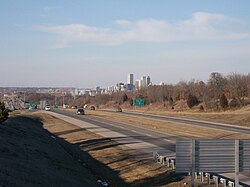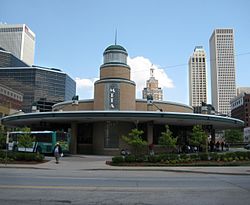Contents


Transportation in Tulsa, Oklahoma includes a bus network and a system of raised highways and primary thoroughfares, laid out in mile-by-mile increments. In addition, throughout its entire length in Tulsa, historic Route 66 is a drivable road, with motels and restaurants reminiscent of the route's heyday era.
Tulsa Transit, the city's transit bus operator, runs 97 buses on 19 different routes across Tulsa and in surrounding suburbs such as Broken Arrow, Sand Springs and Jenks. Tulsa Transit has two stations: the Memorial Midtown Station at 7952 E. 33rd St. in Midtown Tulsa, and the Denver Avenue Station at 319 S. Denver, across from the BOK Center in Downtown. Most routes go through one or both of the stations, facilitating the commute to work and events in Downtown or Midtown. Buses stop at specific stops such as Tulsa Community College, Oklahoma State University-Tulsa, CityPlex Towers, Cox Communications, the various medical facilities in Tulsa, and many shopping destinations, hotels, and schools. The bus schedules are periodically changed; votes are taken by Tulsa Transit to help decide what are the best specifics for certain routes.[1] Tulsa is also implementing a Bus Rapid Transit (BRT) line along Peoria Avenue from 54th Street North to 81st Street South which will feature more frequent buses, upgraded stations, and faster travel times, one of the first 12 cities to adopt such a system.[2]
History
Tulsa streets were simply dirt tracks until after the turn of the 20th century. The first contract for paving was awarded in 1906. Bricklaying did not begin until October of that year and proceeded slowly because local demand for bricks far exceeded the capacity of nearby brick plants.[3] Later, streets were paved with concrete or asphalt.
Streetcars
The Tulsa Street Railway Company (TSR) was formed in 1905 by a group of 18 private investors, led by real estate developer Grant Stebbins.[4] By the end of 1906, TSR had electric streetcars operating downtown along Main, Third and Fifth Streets.[5] One reference states that the street car lines were completed even before the streets were paved.[6] In 1913 TSR was forced to withdraw its service on Cincinnati Hill by the City of Tulsa due to the danger of cars sliding down the hill.[7] In 1909, the Oklahoma Union Traction Company (OUT) built another streetcar line that ran from Owen Park to 18th Street and Lewis, an area now known as Swan Lake. The route went through Downtown on Fourth Street, south on Elgin to 11th Street, and then turned south on Lewis. TSR then built a line from First and Peoria to Kendall College. By 1923, TSR owned 21 miles (34 km) of track and 52 trolley cars. Several more lines were built until the 1920s, when private cars and taxis became more abundant and ridership began to decline. TSR was sold in 1926 to United Service Company. The streetcar system was sold again in 1936 to National City Lines.[8]
OUT went bankrupt in 1935. The trolley wires and rails were removed, and public transportation turned exclusively to buses.[5]
Tourist Shuttle
Starting Nov 2, 2012 the city of Tulsa introduced a newly-revived Tulsa Trolley system that would run every Friday & Saturday from 5pm through 2am to three of some of the City's most popular entertainment areas: the Blue Dome, Brady Arts, and Deco Districts, free of charge.[9][10]
Interurbans
In 1911, the Sand Springs Railway Company built an interurban line connecting Tulsa and Sand Springs. The Tulsa Sapulpa Union Line (originally the Sapulpa and Interurban Railway) connected the two towns with the oilfields.[6] All of the lines are defunct. The Sand Springs line was the last interurban operating in Oklahoma when it ceased operating, on January 2, 1955.[11] The Tulsa Sapulpa line went bankrupt in 1917 and again in 1934, when it acquired its present name. It still operates as a freight-hauling Class III short-line railroad with 23 miles of track connecting BNSF in Sapulpa with Union Pacific in Tulsa.[12]
Railroads
Into the late 1950s several trains of the Frisco, Katy or MKT and Santa Fe railways went in diverse directions from Tulsa's Tulsa Union Depot. Destinations included Chicago, Illinois; Kansas City, Missouri; St. Louis, Missouri; Oklahoma City, Oklahoma; Dallas, Houston, San Antonio and Galveston, Texas.[13] For a brief period in recent years the Iowa Pacific company planned and operated test commercial runs of the Eastern Flyer, a passenger train between Tulsa and Oklahoma City.[14]
Highways
Interstate 44 and the Skelly Drive Bypass crosses Tulsa through midtown from east and west. Its sister highways, Interstate 244 and Interstate 444, make up the inner-dispersal loop surrounding downtown and wrap through the northern part of the city, reconnecting to Interstate 44 in the east and southwest parts of the city. U.S. Highway 412 leaves the city from its most eastern and western points, but through most of its duration in Tulsa, it is primarily concurrent with Interstate 244. U.S. Highway 64 forms the Broken Arrow Expressway to the east and goes as far as the Sand Springs Expressway to the west. U.S. Highway 75 traverses West Tulsa through downtown going north and south, and U.S. Highway 169, also called the Mingo Valley Expressway or the Pearl Harbor Memorial Expressway, generally crosses the city in its eastern areas in a north–south direction. State Highway 11 serves the Tulsa International Airport, connecting from I-244 and Highway 75. The Creek Turnpike splits away from Highway 169 from the South and Interstate 44 from the East, bypassing most of the city of Tulsa and the suburb of Broken Arrow, eventually reconnecting with I-44 in Catoosa to the east and Jenks to the west.
Street network
Tulsa follows a systematic naming and numbering convention for all streets that are within its municipal jurisdiction. Admiral Place is the east–west-running dividing line for "streets north" and "streets south," and Main Street is the north–south-running dividing line for "west avenues" and "east avenues." Avenues west of Main Street are named for US cities west of the Mississippi River for one run of the alphabet, and afterward, numbered "west avenues" are assigned. Avenues east of Main Street are named for US cities east of the Mississippi River for approximately three runs of the alphabet, and afterward, numbered "east avenues" are assigned. Streets north of Admiral Place have important names in Tulsa's history for one run of the alphabet, and afterward, numbered "streets north" are assigned. Streets south of Admiral Place are numbered, beginning with "1st Street" and continuing southward. Street names and numbers are consistent throughout the Tulsa jurisdiction, regardless of whetyger a particular street is contiguous or continuous.
Addresses reflect their associated hundred block from either Admiral or Main. There are usually 16 blocks per mile, as counted by avenues, and there are 10 blocks per mile, as counted by streets. Other right-of-way labels (such as Place, Court, Drive, Terrace, etc.) may be used to describe an intermittent street or avenue, but the actual name will usually be the same as the adjacent street or avenue (such as Knoxville Avenue and its neighboring Knoxville Place, which are both assigned as the 3600 block east).
Major arterial streets can be found at every mile, as assigned by the township-and-range system, resulting in a well-defined grid of thoroughfares across the Tulsa region. As an example, east–west thoroughfares south of Admiral Place are streets ending with a 1, giving 11th Street, 21st Street, 31st Street, etc.
See also
External links
- Tulsa Transit
- Bates, Michael. "Tulsa streetcar and interurban lines in Google Maps." December 15, 2009. Retrieved January 10, 2011. [3]
References
- ^ Route 117 and 118 Proposed Changes Archived June 25, 2013, at the Wayback Machine. Tulsa Transit (June 3, 2013). Retrieved on 2013-08-17.
- ^ "City unveils Bus Rapid Transit stop that 'will open the entire city' from downtown, official says". Tulsa World. Retrieved January 16, 2019.
- ^ TulsaGal Website "Street paving." March 1, 2010. Accessed December 28, 2010.[1]
- ^ Gerkin, Steve. Electric to Eco Trolley: Champions of Tulsa Transportation." This Land Press August 20, 2011. Retrieved December 19, 2014.
- ^ a b "Tulsa Preservation Commission - Transportation (1850 - 1945)."
- ^ a b TulsaGal Website "Streetcars." March 13, 2010. Accessed December 28, 2010.[2]
- ^ "Order No. 742", Seventh Annual report of the Corporation Commission of the State of Oklahoma for the year ending 30 June 1914, Oklahoma City, 1914.
- ^ "Transit Systems in Oklahoma." Retrieved December 19, 2014.
- ^ http://www.tulsaworld.com/scene/article.aspx?subjectid=208&articleid=20121101_455_WK31_CUTLIN718134# [dead link]
- ^ http://www.tulsaworld.com/scene/article.aspx?subjectid=208&articleid=20121103_44_D1_CUTLIN108186 [dead link]
- ^ Gregory, Carl N. Encyclopedia of Oklahoma History and Culture, "Sand Springs." Accessed December 28, 2010.
- ^ "Tulsa Sapulpa Union Railway Website. Accessed December 29, 2010". Archived from the original on January 27, 2011. Retrieved July 24, 2022.
- ^ Santa Fe timetable Spring/Summer 1958 http://streamlinermemories.info/SF/SF58TT.pdf
- ^ "Passenger rail between Tulsa and OKC? Company seeks another Eastern Flyer operator". Tulsa World, June 22, 2018. Retrieved January 25, 2019.


